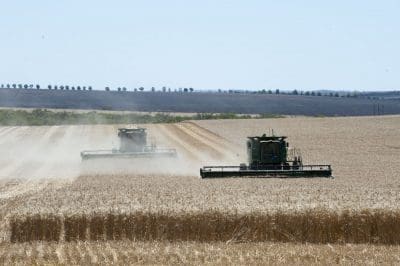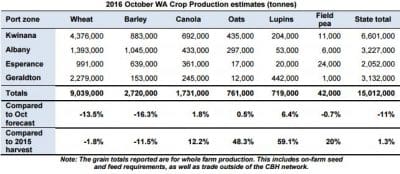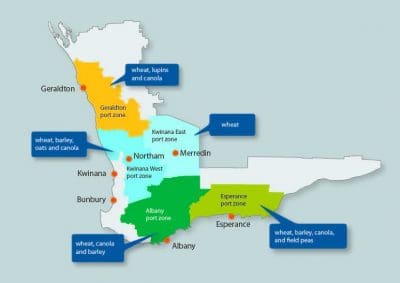A SERIES of damaging frosts in Western Australia in September/October has cut production forecasts for the state’s winter crop by three million tonnes, pruning production estimates to a reduced, but still sizeable, 15-million-tonne crop.

A series of frosts earlier in the season has cut 3 million tonnes from WA’s winter crop forecasts as harvest moves into full swing. Photo: DAFWA
In the latest November crop report produced for the Grain Industry Association of Western Australia (GIWA) by Alan Meldrum, production estimates have been revised downwards from earlier forecasts of a record-breaking 18mt crop.
Mr Meldrum said while it was still one of the best years for crop production in WA, the very cold winter dominated by a series of frost events had cut production potential.
“It is the cumulative effect of many frosts. In our September forecast we were close to 17.7 million tonnes. If we hadn’t had the frosts we would have been pushing 18 million tonnes easily. We have lost around 3 million tonnes out of the potential for the season,” he said.
“But growers budget to lose 5 to 10pc each year because that is the nature of the environment they are in, so the optimistic ones who are looking at ‘the glass half full’ see it as a ‘paper loss’ because they never actually had it in the first place.
“The ones who are really having it tough are the ones who have lost 50pc or more, which will put them back financially four or five years.”
The frost affected regions of WA range widely from the south-east districts of the Geraldton zone, to a wide area of the Kwinana zone, the Lakes region in the Albany zone and the Mallee districts in the Esperance zone.
The WA harvest is in full swing in the Geraldton zone, is picking up pace through the Kwinana zone where barley and canola are coming off, and is underway in the Esperance zone. There is very little happening in the Albany zone to date.
While production losses are being recorded as the harvesters roll through, grain quality issues are also evident.
For wheat, the frost impact will result in substantial amounts of grain being down-graded. This is particularly so in the Geraldton and west Kwinana zones where grain fill was occurring during the frosts. For the Albany and Esperance zones, grain fill had not started and the resultant grain quality from these regions should be largely unaffected, if not enhanced, for protein and size.
Barley has suffered extensive shrivelled and/or distorted grains unsuitable for the malting grade. However, on balance the quantity of malt grade barley is still expected to be adequate for market requirements.
However, canola appears to be the standout crop for yield and quality this season despite the frosty conditions.
“People are reporting outrageous yields with canola. While they are disappointed with the other crops from a frost point of view, they haven’t been disappointed with canola. Even where it has been touched up with frost, it hasn’t lost near as much as the other crops,” Mr Meldrum said.
“Some of the paddock yields are well in excess of what people could have hoped for, particularly in the low rainfall areas.
“Paddock averages of 1.0 to 1.1 tonnes/hectare long term. In low rainfall areas like Wubin they are picking up 1.9 to 2.0t/ha. This is an area 10 to 12 years ago where canola was a fragile crop that only a few brave people were giving a go. But the resilience now in the planting systems and the technology the breeders have brought forward means it is a tough crop and people know how to grow it.
“Because of the good season and slow finish, oil quality is outstanding at around 48 per cent.”
Harvest set to roll in south-eastern Australia
In south-eastern Australia, GrainGrowers regional co-ordinator for southern NSW, Victoria and Tasmania, Clayton Thomas, said many average and below average crops had been sprayed out and hayed off, while the average to above average crops were “moving ahead in leaps and bounds”.
In GrainGrowers Regional Cropping Update, Mr Thomas reported that canola crops in the southern farming zone had begun to be windrowed with an expected harvest around mid-November.
“The cereal harvest will immediately follow that of canola. With all of the crops coming in at the same time, it looks like it is going to be a very chaotic harvest period,” he said.
North strikes chickpea bonanza
In the north, GrainGrowers regional co-ordinator for northern NSW, Queensland and the Northern Territory, Susan McDonnell, said Central Queensland had “taken out the trifecta” this year with the combination of volume, quality and price all coming together for the chickpea harvest for a once in a life time result.
“To date, on the Central Highlands, 90 per cent of the crop is off in the Clermont district and 70pc of the crop has been harvested in the Gindie district. The Rolleston district had a later start and is now about 20pc of the way through their harvest. An average yield for chickpea crops is around 2.5t/ha while some are even up to 3t/ha,” she said.
Further south, Ms McDonnell said grower had been playing the waiting game, frustrated by temperatures that had been unseasonably low while they waited for crops to ripen and dry down.
However, temperatures were on the rise this week with more usual harvest conditions, including hot winds, forecast.
The first barley for the season has been harvested in the Queensland/NSW border region, while wheat and chickpeas are not far off.
“Outstanding cereal yields are expected and the areas of chickpeas that survived waterlogging and disease pressure are also expected to be high,” Ms McDonnell said.



HAVE YOUR SAY